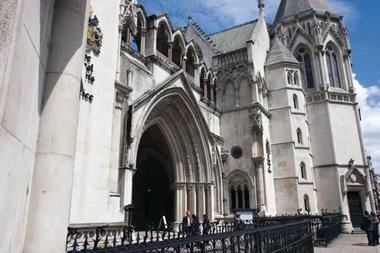An 80-year-old act is being revised to give claimants new rights to pursue the insurers of an insolvent business. Even brokers and loss adjusters could get embroiled. But the situation is perhaps not as scary as it would seem
The breakneck pace of developments affecting the claims sector has left insurers with a lot to keep up with. To the delight of many, the new coalition government is making promising noises about tackling claims inflation, while speculation has been mounting over the outcome of the recently announced consultation on the Jackson Review.
But there is another matter that insurers should not lose sight of. In March this year, the Third Parties (Rights against Insurers) Act was passed, making it easier for claimants to pursue insurers if a company they are claiming against becomes insolvent. Although the change of government pushed back the implementation of the act, it is now widely expected to go live next April.
The new law is predicted to breathe new life into such claims against insurers and potentially increase the sector’s already substantial administrative burden. Legal commentators are warning the insurance world that it must start planning now for the April deadline.
Removing the barriers
The new legislation is set to replace the current 1930 act, which requires claimants to first restore the insolvent company to the Companies House register before they can then approach the company’s insurer for compensation. The Ministry of Justice (MoJ), holds that this process is too lengthy and costly for the claimant. It takes an average of two to three months to complete the application to restore the company to the register, with each application costing around £1,500. This means that, under the existing act, there is little incentive for the claimant to take this path if their potential claim is of relatively low value.
Law firm Berrymans Lace Mawer partner Alistair Kinley explains that the updated act is set to change this. “It is going to simplify the legal procedure for claims against defunct companies because, previously, in order to sue an insolvent company, you had to do one action to restore the company to the companies register and then take another action to sue it in order to get at the insurance. This new act will get rid of that and establish the liability of the insurers,” he says.
According to the MoJ, there were 23,089 corporate insolvencies and 114,340 individual insolvencies in Britain in 2008. Based on a conservative estimate of how many claims such figures could generate per year, the MoJ has calculated that insolvencies could give rise to 120,000 policies over the next 10 years under which third-party claimants could bring a claim under the 1930 act. Consequently, the revisions are expected to save claimants around £7m-£17m in costs over the next decade.
But as the updated act makes it much easier and simpler for claimants to sue for compensation, insurers face the prospect that the changes could spark a wave of claims substantially higher than the forecast 120,000.
“You could well see lower-value claims being pursued with a bit more vigour because in the past they have been abandoned owing to the cost of having to go through hoops under the old act,” law firm Keoghs partner Matthew Rogers says.
Moreover, the new act also removes the technical defences that were open to insurers. Under the 1930 act, an insurer could in theory refuse to pay claims if the insured company failed to notify the claims within the accepted notification period. Now, the revised act allows the third-party claimant to notify the claim within the allocated time frame.
Costly changes
Groupama’s head of large and complex loss, Karl Parr, concedes the lack of wriggle room will prove a wake-up call to some insurers. “I think there is a danger that, as an industry, we may have been guilty of hiding behind some of these defences historically and presenting obstacles when, in reality, if we had been presented with a similar claim against a solvent policyholder we would have quite happily proceeded to deal with it.”
Law firm Stephensons’ solicitor and business development manager, Mark Fenning, warns that the changes brought about by the new act mean insurers must be primed for an inevitable rise in costs. “If you have an increase in claims, you will have an increase in costs. Insurers need to start thinking about preparing for those costs, perhaps by laying down better risk assessments on policies or increasing premiums.”
In addition, the 2010 act will allow claimants greater power to demand disclosure of information about a company’s insurance policy from the insurer and a broader pool of parties connected with the policy, such as brokers and loss adjusters. Law firm Burges Salmon senior associate Tim Pope explains: “Under this act, there are wide information provision requirements for anyone who potentially has a claim to ask anybody else who they think might have the information.
“That includes a number of other parties within the insurance world. Anyone who might be able to provide the information will have to provide it.”
The last straw
In many ways, this additional red tape and new timescales could not have come at a worse time for the sector as it grapples with new administrative burdens like meeting the requirements of the MoJ reforms for RTA personal injury claims and Freedom of Information requests.
In addition, once a request for information is submitted, the insurer is given 28 days to comply. The penalties for failing to meet this timescale could also prove an issue for insurers, many of which are not renowned for their prompt timekeeping.
“There is a cost sanction in there as well,” GAB Robins casualty operations manager Mark Wookey says. “If the party doesn’t provide the information within the expressed timescale, the claimant can then place an order with a court and no doubt they will pass those costs on.”
Claims rising
So where are these claims likely to spring from? Berrymans’ Kinley reckons that the first batch of claims brought under the revised act are most likely to spring from the beleaguered construction sector, alongside a likely spate of historical disease claims.
But, to a large extent, the rate at which claims are set to rise will depend on the economy. “In a worst-case scenario, where the economy continues to be in difficulty for some time and insolvencies continue to rise, that will mean a growing number of cases or potential cases where the act could be used,” Wookey says.
For the most part, insurers are putting a brave face on the prospect of extra work, arguing that they have a strategy in place. Aviva’s senior claims manager, Andrew Wilkinson, says: “Any claim of this type, where an insured may be insolvent or no longer trading, highlights the importance of early reporting of incidents.
“It also highlights the need for a prompt and thorough investigation of all the circumstances, so that information can be obtained or witnesses interviewed to support decision-making.”
Meanwhile, Allianz head of property and casualty Steve Coates strikes an optimistic chord. “There may be a slight increase in the number of claims that can be brought as a result of this legislation, but we do not expect the effect to be significant,” he says.
Plus points
Indeed, it is not all bad news for insurers. For organised players, the act could spur a more efficient claims process, leading to cost savings. “The new act allows for some of the information to be available earlier,” Groupama’s Parr argues,
“so that decisions can be made regarding both policy liability and legal liability, and hence won’t be clogging up our claims departments.”
In addition, Kinley suggests that the new act has advantages for insurers, as it allows them to chase up their own claims against insolvent companies. “There may also be some insurance recovery claims where insurers paid out and are looking to pursue another party, and that party has gone out of business. So the insurer might actually use the provisions of the act to purse those subrogated claims,” he says.
For example, if an insurer had met the costs of fire damage in a factory owing to a faulty sprinkler system, they could be in a position to sue the manufacturer of the system. If this company had become insolvent, however, the act will remove the obstacles for insurers, allowing them to recover their costs more quickly from the insolvent company’s insurer.
Ultimately, the message is that change is coming and insurers need to get ready. Indeed, as Parr admits, change is long overdue.
“I think on the whole it is something we shouldn’t be afraid of: it allows us to get on and deal with valid claims, because these are risks we have collected the premium for. The current act is 80 years old and was good in its time, but lots of things have moved on.” IT



































No comments yet